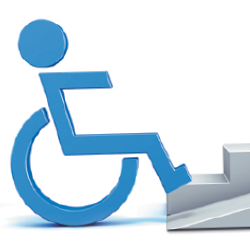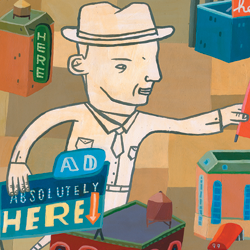Fire emergencies are rare on the show floor, but they
do happen. Learn how to spot common fire hazards to keep your next booth from going up in flames. By Candy Adams

ave you ever had to put out a fire in your booth? I'm not talking a proverbial fire – I'm talking real flames. I've had a handful of close calls, including one at my first show. The halogen lighting behind a computer demo station fried the cables, bringing our demo to an abrupt end. Fortunately, most of the crowd left when the smoke started and the demo stopped, and we were able to unplug the halogens without incident.
Aside from halogens, other fire hazards include poorly ventilated computer equipment, flammable materials, and faulty wiring. Fortunately, most of these issues can be prevented with a basic understanding of the fire rules included in every exhibitor services manual. Here, then, are seven of the most common fire-safety regulations that govern trade show exhibits.
 Exhibit Materials
Exhibit Materials
Booth construction and decoration materials must be fire retardant with a certificate of retardancy. Without the certificate, which can be acquired from the manufacturer of the item, the materials might be subject to onsite testing by the fire marshal. Fabrics must pass the NFPA-701 Code, and all other materials must pass the NFPA-703 Code. The fire marshal will mandate the removal of all materials that fail these tests.
 In-Booth Storage
In-Booth Storage
Exhibitors can't store anything behind exhibits or near floor ports, electrical wiring, junction boxes, or cabling. Pallets, empty crates, boxes, and cartons also can't be stored within the booth space. Furthermore, storage of brochures, fliers, catalogs, etc. is limited to a one-day supply that must be in a display case, in a closet, on a counter, on a shelving unit, on or under a table, or stacked neatly within the booth space.
 Covered and Double-Deck Exhibits
Covered and Double-Deck Exhibits
Building an enclosed, double-deck exhibit in a convention center is literally constructing a building inside a building. To make sure that both buildings adhere to fire-safety regulations, extra measures might be required since the exhibit floors and/or ceilings would prevent the venue's sprinkler system from discharging water unobstructed to the show floor. Remedies include installing a full sprinkler system in exhibits with large covered areas, installing approved smoke detectors with audible alarms, and/or placing fire extinguishers in all covered areas.
If you are using multilevel exhibits with enclosed areas, contact the convention center's fire marshal and structural engineer to determine the specific rules as soon as you start designing your exhibit. The fire marshal will generally request a copy of the booth plan for approval. Depending on the city and convention center, there may be a charge for reviewing and (hopefully) approving your exhibit design.
 Electrical Wiring
Electrical Wiring
In-booth electrical installations must conform to the Uniform Building Code and the National Electric Code, and electrical equipment must be Underwriter Laboratories (UL) approved. All 110V extension cords need to be grounded, at least 14-gauge, and flat, with the UL label still attached. Multiplug adapters (aka power strips or surge protectors with circuit interrupters), must be UL approved and have built-in overload protection. Cube-tap adapters, which convert one electrical socket into three to six sockets, are generally prohibited on the show floor. Temporary wiring must be accessible and free from debris. Electrical work under exhibit carpets must be done or supervised by the trade show's official electrical contractor using type SO cord ("S" stands for severe service cord and "O" stands for oil-resistant outer jacket) that is insulated to qualify for extra hard usage. The cord must be No. 12 American wire gauge (AWG) or larger.
 Lighting
Lighting
Some trade show venues have banned the use of 100W, quartz halogen light fixtures with a linear quartz bulb or nonshielded halogen bulb, due to exploding lights. Handling halogen bulbs with bare hands –
instead of wearing the cotton gloves included with the replacement bulbs – leaves an oily residue on them that then creates hot spots. Those hot spots can cause halogen bulbs to overheat and explode.
Industry Update
Fire-Code Changes
According to Daniel Cozzi, fire safety manager at McCormick Place in Chicago, the convention center has recently changed its regulation that previously prohibited exhibitors from storing show materials under tables within their booth spaces. The venue now allows a one-day supply of materials to be stored under tables (but still prohibits storage behind the back walls of linear exhibits).
The Las Vegas Convention Center (LVCC) has also recently changed its fire-safety policies and updated its fire-suppression system. "During the last year, the LVCC completed a major fire-sprinkler upgrade that is second to none at protecting life and property within an assembly occupancy," says Michael Massey, CFI-II, CBPE, fire prevention coordinator at the Las Vegas Convention and Visitors Authority. "This new system is quite powerful and far exceeds the minimal code requirements for assembly halls." In addition, the Clark County Fire Department amended the local fire code last September. In most cases, a fire watch and temporary fire-sprinkler system are no longer required for covered exhibits and deck structures.
Massey says another subject that should be of interest to most exhibitors is the gradual shift from halogen lighting to LED. "During the past 10 years the lighting industry has made huge advancements in LED technology for exhibits," he says. "The latest technology addresses several key issues: It helps to reduce expense, provides excellent illumination with minimal energy requirements, negates fire-causing high heat, and benefits several Green objectives."
 Vehicles on the Show Floor
Vehicles on the Show Floor
Generally, vehicles on display in an exhibit should have a limited amount of fuel (no more than one-eighth- to one-quarter-tank of gas, or maximum of five gallons), a locked or taped fuel-tank filler cap, and disconnected battery cables, the ends of which may need to be taped. Someone on the general service contractor's material-handling staff must drive the vehicle on the show floor, and the keys have to be kept in an accessible location in case the vehicle needs to be removed from the convention center in the event of an emergency. Don't store combustible materials beneath vehicles. You might be required to provide and place a fire extinguisher near the vehicle.
 Hazardous Materials
Hazardous Materials
Pre-approval might be required by fire-safety personnel if the following devices or materials are being used in the booth: lasers, open flames, smoke-producing devices, indoor pyrotechnics, heating appliances, welding/brazing/cutting equipment, radioactive materials, compressed gas or liquid cylinders, and flammable or toxic liquids, solids, and gases.
Unfortunately, even the best-laid plans can go up in flames – literally. And regardless of how many precautions you take, there's no guarantee the exhibit next door is taking fire safety quite as seriously. While an ounce of prevention is worth a pound of cure, you still need a game plan in case someone smells smoke. So in the event of a fire emergency, pick up a house phone (generally found on the walls lining the perimeter of the exhibit hall) and dial the number posted on the phone. If there's no number, stay on the line until the operator answers. The operator will notify the appropriate department at once, dispatching it based on the location of the phone you're using and the booth number you provide nearest to the emergency situation. Using the house phones can help safety and security personnel find your location within the exhibit hall quickly. That said, if you don't see a house phone nearby, call 911.
Although many exhibiting rules are typically bendable on a case-by-case basis, fire safety is not something to mess around with. And while I've covered some of the most common fire regulations, you must still read the guidelines and restrictions printed in the exhibitor services manual specific to your show and its venue. Knowing your venue's fire-safety rules will keep your exhibit from going up in smoke at your next show. 




 ave you ever had to put out a fire in your booth? I'm not talking a proverbial fire – I'm talking real flames. I've had a handful of close calls, including one at my first show. The halogen lighting behind a computer demo station fried the cables, bringing our demo to an abrupt end. Fortunately, most of the crowd left when the smoke started and the demo stopped, and we were able to unplug the halogens without incident.
ave you ever had to put out a fire in your booth? I'm not talking a proverbial fire – I'm talking real flames. I've had a handful of close calls, including one at my first show. The halogen lighting behind a computer demo station fried the cables, bringing our demo to an abrupt end. Fortunately, most of the crowd left when the smoke started and the demo stopped, and we were able to unplug the halogens without incident. 









